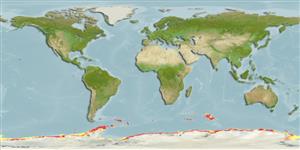>
Perciformes/Notothenioidei (Icefishes) >
Nototheniidae (Cod icefishes) > Nototheniinae
Etymology: Notothenia: Greek, 'notos', ou; νοτος, ου), from the south + Greek, 'e 'eutheneia',as or 'euthenia', as (ευθενεια, ας; ευθενια, ας), abundance (P. Romero, pers.comm. 01/16); coriiceps: coriiceps from Latin corium skin or leather plus ceps head = skin head or leather head (Ref. 11892).
More on author: Richardson.
Environment: milieu / climate zone / depth range / distribution range
Écologie
marin démersal; profondeur 0 - 550 m. Polar; 46°S - 78°S, 180°W - 180°E
Southern Ocean: probably circum-Antarctic on the continental shelf. So far, known from the western Ross Sea, Balleny islands, Adélie Land, Antarctic Peninsula and associated islands, islands of the Scotia Arc to South Georgia, Weddell Sea, Bouvet, and the sub-Antarctic islands of the Indian Ocean sector.
Length at first maturity / Taille / Poids / Âge
Maturity: Lm 36.5 range ? - ? cm
Max length : 62.0 cm TL mâle / non sexé; (Ref. 5179); common length : 50.0 cm TL mâle / non sexé; (Ref. 2121)
Description synthétique
Clés d'identification | Morphologie | Morphométrie
Épines dorsales (Total) : 4 - 6; Rayons mous dorsaux (Total) : 35 - 38; Rayons mous anaux: 26 - 30. Wide interorbital space, fewer pectoral rays, lack of scales below the eye (Ref. 11892).
Most commonly found in less than 200 m (Re. 5179). Stomach contents included
mainly small crustaceans (Amphipoda and Euphausiacea) and seaweeds (Ref. 122792).
Dewitt, H.H., P.C. Heemstra and O. Gon, 1990. Nototheniidae. p. 279-331. In O. Gon and P.C. Heemstra (eds.) Fishes of the Southern Ocean. J.L.B. Smith Institute of Ichthyology, Grahamstown, South Africa. (Ref. 5179)
Statut dans la liste rouge de l'IUCN (Ref. 130435)
Menace pour l'homme
Harmless
Utilisations par l'homme
Pêcheries: d'intérêt potentiel
Outils
Articles particuliers
Télécharger en XML
Sources Internet
Estimates based on models
Preferred temperature (Ref.
123201): -1.7 - 2.4, mean -0.6 °C (based on 170 cells).
Phylogenetic diversity index (Ref.
82804): PD
50 = 0.5078 [Uniqueness, from 0.5 = low to 2.0 = high].
Bayesian length-weight: a=0.00661 (0.00544 - 0.00803), b=3.22 (3.16 - 3.28), in cm total length, based on LWR estimates for this species (Ref.
93245).
Niveau trophique (Ref.
69278): 2.8 ±0.35 se; based on food items.
Résilience (Ref.
120179): Faible, temps minimum de doublement de population : 4,5 à 14 années (Assuming tm>4).
Fishing Vulnerability (Ref.
59153): High vulnerability (60 of 100).
Climate Vulnerability (Ref.
125649): Moderate to high vulnerability (50 of 100).
Nutrients (Ref.
124155): Calcium = 20.8 [12.1, 47.6] mg/100g; Iron = 0.412 [0.189, 0.797] mg/100g; Protein = 18 [16, 20] %; Omega3 = 0.326 [0.178, 0.568] g/100g; Selenium = 18.9 [7.9, 43.2] μg/100g; VitaminA = 9.04 [2.05, 41.45] μg/100g; Zinc = 0.491 [0.330, 0.740] mg/100g (wet weight);
